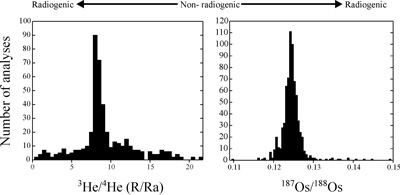 |
 |
Helium-Osmium
Systematics |
|
|
Anders
Meibom
Laboratoire d'Etude de la Matiere
Extraterrestre, USM 205 (LEME), Case Postale 52, Museum
National d'Histoire Naturelle, 61 rue Buffon, 75005
Paris
meibom@mnhn.fr
|
An increasingly large body
of isotopic and trace-element analyses of mid-ocean
ridge basalts (MORBs) demonstrates that the upper
mantle is not homogenous but contains several distinct
geochemical domains on a variety of length scales
[Graham et al., 2001; Hofmann, 1997;
Meibom
et al.,
2002; Zindler and Hart, 1986]. However,
the physical properties of these domains, including
their exact location, size, temperature and dynamics,
remain largely unconstrained.

He and Os
isotopic distributions of unfiltered, global spreading
ridge data
Perhaps
the most important example of an inferred genetic relationship
between a geochemical signature and a specific geophysical
phenomenon is provided by He isotopes and conjectured
deep-rooted mantle plumes. Preponderance of opinion
among geochemists is that the distinct He isotopic signatures
(i.e. high 3He/4He
ratios) associated with certain locations, such as
Hawaii, Yellowstone and Iceland, indicate a link,
via such mantle plumes, to a primordial and undegassed
reservoir isolated in the lower mantle. In this interpretation,
the He isotopic signatures of “hotspot” basalts
provide geochemical evidence for large scale stratification
of the mantle and the presence of an “undegassed,
primordial lower mantle reservoir” [Farley
and Neroda, 1998; Kellogg and Wasserburg,
1990; Porcelli and Wasserburg, 1995]. Recently,
however, an alternative to this interpretation has been
explored [Meibom
et al., 2003].
The
unfiltered He isotope data set for MORB displays
a wide, nearly Gaussian, distribution [Anderson,
2000], qualitatively similar to the Os isotopic
(187Os/188Os)
distribution of mantle-derived Os-rich alloys
[Meibom
et al.,
2002] (see figure). Both distributions could
result from shallow mantle processes involving
the mixing of different proportions of recycled,
radiogenic and unradiogenic domains. These could
be generated as follows.
|
In
the case of the (U+Th)-He isotope system, the
capture of He-rich bubbles by growing olivine
phenocrysts in crystallizing magma chambers [Natland,
2003] effectively separates He gas from U+Th.
This prevents additional 4He,
produced by the radiogenic decay of U+Th, from
adding to the He gas in the bubbles and reducing
its 3He/4He.
In this way, old, unradiogenic (high) 3He/4He
is “frozen in” and preserved. The
higher-than-chondritic (U+Th)/He elemental ratio
in the MORB melt, however, results in the relatively
rapid growth of 4He,
and this, coupled with the partially degassed
nature of the MORB melt, causes 3He/4He
to reduce rapidly, and thereby provide the radiogenic
(i.e. low 3He/4He)
endmember. |
During partial
melting, Re is mildly incompatible, whereas Os
is strongly compatible. This results in high Re/Os
ratios in basalts, and correspondingly low Re/Os
in the refractory, depleted solid residue left
behind in the mantle [Shirey and Walker,
1998]. Thus, 187Os/188Os
in basalts and the residue rapidly diverges after
melting and separation. Radiogenic (MORB-rich)
and unradiogenic (depleted mantle residue) 187Os/188Os
endmembers are constantly produced by partial
melting events. |
|
If this model
is correct, the assumption that high
3He/4He
is diagnostic of a plume component in oceanic basalts
is not justified.
|
-
-
Farley, K.A., and E. Neroda,
Noble gases in the Earth's mantle, Ann. Rev.
Earth Planet. Sci., 26, 189-218,
1998.
-
Graham, D.W., L. J.E., S. F.J.,
and C. D.M., Upper-mantle dynamics revealed by helium
isotope variations along the southeast Indian Ridge,
Nature, 409, 701-703,
2001.
-
Hofmann, A.W., Mantle geochemistry:
the message from oceanic volcanism, Nature,
385, 219-229, 1997.
-
Kellogg, L.H., and G.J. Wasserburg,
The role of plumes in mantle helium fluxes, Earth
planet. Sci. Lett., 99, 276-289,
1990.
-
Meibom,
A., D.L. Anderson, N.H. Sleep, R. Frei, C.P. Chamberlain,
M.T. Hren, and J.L. Wooden, Are high
3He/4He
ratios in oceanic basalts an indicator of deep-mantle
plume components? Earth planet. Sci. Lett.,
in press, 2003.
-
Meibom,
A., N.H. Sleep, C.P. Chamberlain, R.G. Coleman,
R. Frei, M.T. Hren, and J.L. Wooden, Re-Os isotopic
evidence for long-lived heterogeneity and equilibrium
processes in Earth's upper mantle, Nature,
419, 705-708, 2002.
-
Natland, J.H., Capture of mantle
helium by growing olivine phenocrysts in picritic
basalts from the Juan Fernandez Islands, SE
Pacific, J. Pet., in press,
2003.
-
Porcelli, D., and G.J. Wasserburg,
Mass transfer of helium, neon, argon and xenon through
a steady-state upper mantle, Geochi. Cosmochim
Acta, 59, 4921-4937, 1995.
-
Shirey, S.B., and R.J. Walker,
The Re-Os isotope system in cosmochemistry and high-temperature
geochemistry, Ann. Rev. Earth Planet. Sci.,
26, 423-500, 1998.
-
Zindler, A., and S.R. Hart, Chemical
Geodynamics, Ann Rev Earth Planet Sci.,
14, 493-571, 1986.
last
updated 30th March, 2005 |
|
|
